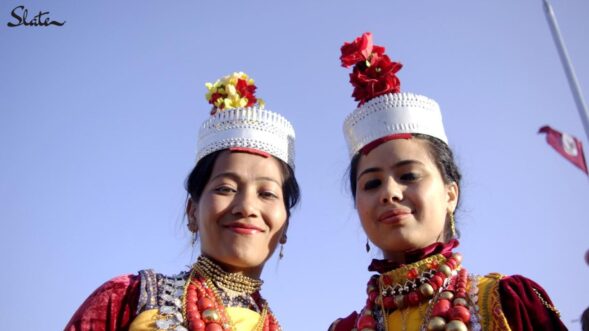
By Adity Choudhury
Stories do not end with death for the dead carry with them a sense of timelessness. Walk around Kolkata and numerous 19th century cemeteries dot the city.
Relocating to a new city is by no means easy, so it was but natural for me to look for the ‘familiar’… to find traces of home. And, so I visited the Scottish Cemetery, known for a significant tombstone. Any guess, who?
None other than the famous Reverend (Rev) Thomas Jones, the “Father of the Khasi Alphabet”. Initially excited at the prospect of meeting him, a bigger revelation awaited for this Shillong-bred (self-professed) cemetery enthusiast.
“People come to visit his grave, mostly from Shillong,” one of the caretakers said while showing me the way to the Reverend’s tomb, which has acquired something of a celebrity status.
Inside, the silence permeates one’s being – the chaos outside suddenly comes to a standstill and this feeling of being suspended in another time hits you,
Speaking to the historian and conservationist, Neeta Das, who has been associated with restoration work here for 12 years, revealed more about the cemetery. “There are 4000 people buried here. One could say that the Scottish Cemetery is home to the Anglo-Indian community. This space tells the story of 19th century Kolkata.”
Reading the introduction section of their website gives an idea, “Park Street was originally known as Burial Ground Road and with the grand South Park Street Cemetery, the now-destroyed North Park, Mission and Tiretta Cemeteries and the sprawling and still-in-use Lower Circular Road Cemeteries, the name would indeed make a lot of sense… Just across the road, and a short walk away from the South Park Street Cemetery and its famous tombs of Sir William Jones, Rose Aylmer and ‘Hindoo’ Stuart, one finds the Scottish Cemetery, earlier known as the Scots and Dissenters’ Cemetery, Calcutta. The cemetery is not too easy to spot and one needs to turn into the rather narrow Karaya Road, once notorious as the European red-light quarter. A two-minute-walk down the road past motor garages takes you to the Scottish Cemetery. The cemetery is now under the supervision of St. Andrew’s Church, Dalhousie Square and conservation work is being carried out by the Kolkata Scottish Heritage Trust (KSHT).”
Cultural Collision
The 19th century is a fascinating period in Indian history. The Khasi-Jaintia and Garo Hills were no exception in this regard.
British expansion in undivided Assam also meant cultures were at a collision course – an air of dissent as well as cultural synthesis existed. Modern western education, missionary activity and the dawn of consciousness leading to preservation of indigenous cultures make this period thrilling.
Rev. Jones played a significant role as society underwent a transition. While Meghalaya now observes Thomas Jones Day (June 22) to commemorate his arrival is Sohra (British renamed as Cherrapunjee) and perhaps, for his contribution in developing Khasi script, there was more to him.
Das pointed out, “Scottish Cemetery was known as the ‘Cemetery of Dissenters’. My journey started out as a conservationist and now I find myself asking questions about 19th century Calcutta.”
On enquiring about what she meant by dissenter in this context, she said, “The story of the Anglo-Indian community sheds important light on the society of that time. There is a tragic element. You see these marriages were considered illegal. Children born out of such unions were considered bastards because of their questionable parentage. There was a sense of belonging nowhere and they fell outside the purview of the caste system. Neither the English nor the Indian worlds completely accepted them.”
The conversation steered towards the Reverend and how he came to be here. For the historian and conservationist, this is fascinating. “If you ask me, it’s the process of how the Khasi alphabet was born that interests me. Who helped him in his work? Why is he buried here, of all the places?”
Meeting the Dissenter
The Welsh missionary showed an active interest in mission work from an early age and expressed his desire to work in India. Following the decision to send him to the British colony by the Welsh Presbyterian Calvinistic Mission Methodist Foreign Missionary Society, he embarked on a long, arduous journey to the Khasi Hills.
Aged 30, he along with his pregnant wife, Anne Jones boarded a ship to Kolkata. After several months, they reached their destination in April, 1840. Tragedy struck when his first child died in childbirth. Drawing comfort from the Scriptures, they continued on their journey to Cherrapunjee via Sylhet in erstwhile East Bengal.
Reaching their final destination on June 22, 1841 involved climbing steep hills, travelling on a horse and Anne being carried in a basket. Lieutenant William Lewin warmly welcomed the young couple, which became a source of comfort in an alien land.
Soon, the Reverend started his mission work, learning the Khasi language within seven to eight months of arrival. He rejected the Bengali script that was used by the Khasis to write in favour of the Roman alphabet. Three schools were established at Mawsmai, Mawmluh and Sohra to educate children – he saw this as the stepping stone to educate the people about Christianity. Vocational training, too, was an integral element of mission work. Eager villagers were taught innovative ways of doing agriculture, carpentry, lime-mortar masonry and coal mining, for instance.
Gradually, the local population warmed up to him as he became a legendary figure. Five years of perseverance paid off as the faith spread in and beyond Sohra.
All seemed to go well until another tragedy struck. His wife passed away while delivering their second child. He remarried, resulting in disagreement with the mission society for marrying a minor by the name of Emma Catell – they did not approve this and refused to endorse his evangelical work.
But a bigger conflict soon followed, this time (ironically) with an Anglo-Indian businessman Harry Inglis. That Rev Jones thought of the well-being of the native population irked the latter, known for his exploitative and ruthless ways. Inglis not only monopolised the lime and orange trade in the 1830s-40s but paid the farmers inadequately. In siding with the farmers, the missionary filed a case against him, but lost the case.
Prof. Andrew May, in his paper titled, Small stories of Little Britons: scale and the ethics of imperial histories, published in 2016, wrote about Inglis, “Harry Inglis was a notorious merchant and bully boy in the Khasi Hills in the 1830s and 1840s, the Indian-born son of a Scottish lime merchant and an Indian mother. He died in London in 1860, and his body was sent back to the Khasi Hills, pickled in a barrel. In 1862, Harry’s widow Sophie installed his corpse standing up in a glass coffin in the verandah at Kut Madan, telling the Khasis ‘that he would rise from the dead and avenge himself on any person who wronged her’. Sophie’s logic played on the fear that Khasis still felt of Harry’s power, even in death. Under Harry’s agreements with the Khasis, his leases on the orange groves were good for his lifetime, which in Khasi translated as ‘for as long as he remained above the ground’.”
Regarding the legal conflict between Inglis and Jones, author Patrick Rogers mentioned in his blog, “Thomas Jones is perhaps the most important European figure in Khasi history. And yet, counter to the narrative that missionaries in India were simply colonial vanguards, his activities were far from appreciated by the British administration in Sohra. This was because he publicly butted heads with the primary British trading concern in the region during the 19th century, Inglis & Co. Founded by George Inglis at Sylhet (in present day Bangladesh) during the 1790s, this organisation had already established a monopoly over trade in such commodities as oranges, coal, and limestone between the hills and the plains even before Europeans set foot in the highlands. By the time Jones was operating at Sohra, George Inglis’s half native son Harry had been conveniently appointed assistant to David Scott’s successor as Political Agent, Colonel FG Lister, who was also, scandalously, Harry’s father-in-law. This position allowed the younger Inglis to, in effect, act as the local magistrate, an arrangement which he promptly turned to his personal advantage.”
The author goes on to write about the consequences of their strategic alliance. As Lister’s second-in-command, he dominated both the economy of the Khasi Hills and the local courts. His corruption did not go unnoticed and among his staunchest critic was the Welsh missionary who questioned the injustice incurred on the local population. In return, his family was harassed. Fearing for his life, he escaped to Kolkata and passed away, aged 39 after contracting malaria.
Sitting beside the grave of Rev. Jones in Kolkata, one wonders about the nuances of colonial rule. Presently, visitors who come here belong to the Anglo-Indian community. In 19th century Khasi Hills, a Welsh missionary earned the wrath of an Anglo-Indian trader. The irony of history remains.
The Scottish cemetery is a treasure trove of stories and much remains to be unearthed. Years of neglect has caused much damage to older graves – either inscriptions have completely faded or they’re unreadable. Buried with the people here are stories that make us think about how cultures were re-defined in colonial India.






